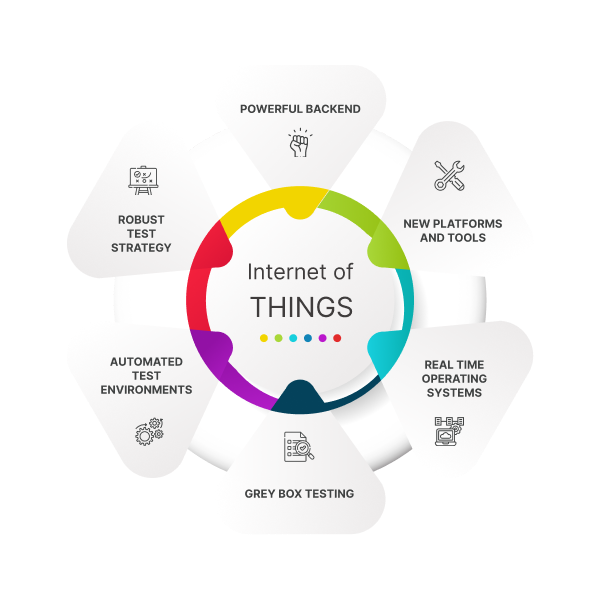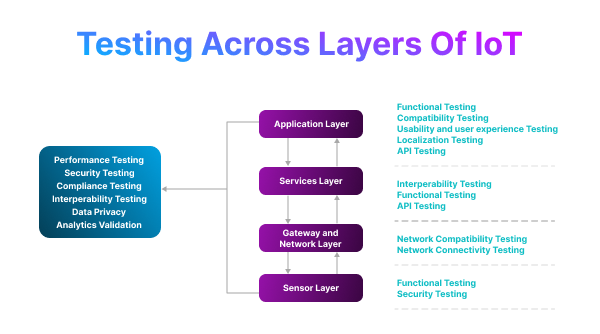“The global IoT market is expected to reach $1.1 trillion in 2023” ~ IDC
The concept of digital transformation has brought the world closer to the revolutionary technologies. Right from the introduction of internet to the rapid adoption of mobile devices, the world has never been the same.
Amidst all the hype for digitalization across industries, Internet of Things or IoT has emerged to be one such mainstream technology that has given more meaning to the business innovation of the future.
Besides, when it comes to innovation, one of the latest applications and innovations of surrounding IoT is IoT testing services. Enthusiasts call it IoT Testing-as-a-Service and it is presently seen as a doorway to advanced automation.
From offices to homes, IoT has offered all the convenience and ease for strengthening industrial as well as consumer use cases. And therefore, considering the extensive potential, more and more enterprises are aligning IoT into test processes, through Testing-as-a-service.
IoT testing allows testers to work on functional and integration testing to check on various features and performance benchmarks surrounding a software where a large amount of data is being transferred.
With that being said, let us dive through IoT Testing in a little more detail by walking through what it can offer, the challenges related to IoT testing services, structure of an IoT Testing framework, and the various tools that can complement IoT TaaS initiatives.

During the last few years, IoT has created a significant impact on software business industry driving massive growth through simplified digital transformation. With a predicted significant rise in the number of IoT devices, it is extremely necessary that stable and robust IoT solutions must reach the market.
IoT testing works through testing of various unique devices in order to generate variable data that is harnessed to understand the possible challenges related to development, deployment, and scaling.
At present, Importance of IoT testing is seen with a broadened perspective. IoT testing is now being harnessed as a more comprehensive and dynamic approach to IoT integration within the existing digital environment. Especially, it complements the traditional approach to software testing adding a multidisciplinary approach where everything from testing scenarios to strategies, automation, virtualization, and measuring tools are covered.
Since IoT holds the power of internet to allow data transfer, IoT testing-as-a-service could go a long way in improving the test methodologies as well as taking the most part of test process to cloud.
This leads us to the question that what might restrict harnessing the full potential of IoT app testing services? Let us jump on learning challenges surrounding IoT testing.
IoT testing is the composition of different approaches with a differentiated set of components consisting of application software, hardware, server software, network, and client platforms. Besides, IoT systems require to offer huge throughput to work across networks which brings along the hassle of dealing with varying environmental situations and innumerable users.
Let us quickly walk through common challenges surrounding testing internet of things to learn the advanced approach to simplify end-to-end testing using IoT devices:
Since it is not feasible and practical to test each scenario, testing through an IoT system require a thorough understanding of end-use situations, automatic test suite, and highly specific domain knowledge.
Learn What Makes IoT Testing An Essential For Healthcare Sector!
Read Here: Importance of IoT Testing in Healthcare
The IoT systems is usually built over four different layers. These include application layers, services layer, gateway and network layer, and the senor layer. And therefore, any IoT testing framework made needs to work through each of these layers to ensure the success of any application or product under test.
Usually, the application layer requires testers to work through functional, compatibility, usability, localization, API, and user experience testing.
At stage two, testers work on interoperability, functionality, and API testing for the services layer to identify IoT security issues.
At stage three or Gateway and network layer, testers keep a check on compatibility and connectivity testing.
Lastly, the sensor layer again needs testers to check on functional and security element.
Apart from these, the IoT testing framework involves keeping a check on performance, compliance, security, data privacy, interoperability, and analytics validation also.

As we have mentioned earlier about the dynamic nature of the IoT environment, testing for all the above-defined layers require automation, measurement, simulation, and virtualization tools to meet the IoT testing initiatives. Some of the common tools that could help simplify the IoT testing approach include:
Since device and protocols are standard compliant, they are usually configured using tools that can allow bulk simulation.
To automate the task of execution, all the devices, apps, and system under use is recorded and played using the simulators.
These tools are usually made to complement functional mobile testing and replicate the end-user experience to reflect if an application works as expected or not.
Made to complement static code investigation, application security testing tools are made to check on runtime danger as well as demonstrations. These are usually tackled using high-end tools like Acunetix and Netsparker using device arrangements like Micro Focus, Fortify on Demand, OWASP ZAP, etc.
Since most API testing tools are built over REST APIs and Web services, API testing for IoT could be worked using tools like Telerik, Postman, SoapUI, etc. To check on latency, response, performance, and connectivity of the system under test.
For IoT testing using automated tools does not mean virtual machines or test environments. Here testing is done using tools like Foreman and Katello that can activate the tests within a CI/CD environment.
Apart from these, testers could take helps of tools like wireshark to observe traffic, Fiddler to debug the traffic, while JTAG Dongle to check hardware and framework. Also, defect management tools could be deployed to improve internal control efficiency, momentum, and overall effectiveness on IoT Application testing.
While automation testing has enabled the tech world to progress, IoT testing bridges the gap between testing requirements relating to tools, strategies, communication, and more.
Besides, the wise use of simulation models could enable real-time testing, adding more value to the strategic testing approach with an improved selection of test tools.
And just in case, you need some expert assistant on IoT testing services, our experts at BugRaptors have all the expertise to plan and streamline your testing journey.
For more information, reach us through info@bugraptors.com
Interested to share your
Read More
BugRaptors is one of the best software testing companies headquartered in India and the US, which is committed to catering to the diverse QA needs of any business. We are one of the fastest-growing QA companies; striving to deliver technology-oriented QA services, worldwide. BugRaptors is a team of 200+ ISTQB-certified testers, along with ISO 9001:2018 and ISO 27001 certifications.
Corporate Office - USA
5858 Horton Street, Suite 101, Emeryville, CA 94608, United States
Test Labs - India
2nd Floor, C-136, Industrial Area, Phase - 8, Mohali -160071, Punjab, India
Corporate Office - India
52, First Floor, Sec-71, Mohali, PB 160071,India
United Kingdom
97 Hackney Rd London E2 8ET
Australia
Suite 4004, 11 Hassal St Parramatta NSW 2150
UAE
Meydan Grandstand, 6th floor, Meydan Road, Nad Al Sheba, Dubai, U.A.E